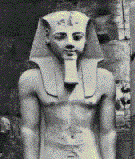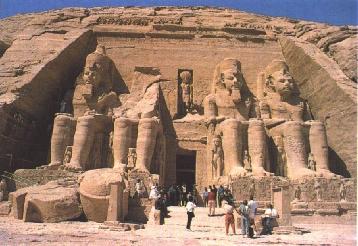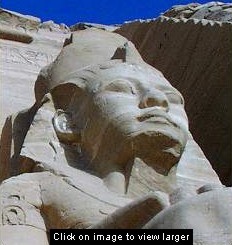|
|
|


 Ramses II (1279-1212 BC) was an ancient Egyptian king, third ruler of the 19th Dynasty, and the son of Seti I. According to
tradition, he was the Pharaoh of Egypt in the biblical Exodus story.
Ramses II (1279-1212 BC) was an ancient Egyptian king, third ruler of the 19th Dynasty, and the son of Seti I. According to
tradition, he was the Pharaoh of Egypt in the biblical Exodus story.
During the early part of his reign, Ramses fought to regain the territory in Africa and western Asia that Egypt had held during the 16th
and 15th centuries BC. His principal opponents were the Hittites, a powerful people of Asia Minor, against whom he waged a long
war. The major battle of this war was fought in 1274 BC at Kadesh, in northern Syria, and showed Ramses as the winner. Neither
power achieved a conclusive victory, however, in 1258 BC a treaty was signed whereby the contested lands were divided and
Ramses agreed to marry the daughter of the Hittite king. The remaining years of his rule were distinguished by the construction of such
monuments as the rock-hewn temple of Abu Simbel, the great hypostyle hall in the Temple of Amon at al-Karnak, and the mortuary
temple at Thebes, known as Ramasseum.
 Ramses II has recently gained prominence among egyptologists following the 1995 discovery of this pharaoh's family mausoleum, the
largest tomb ever found in Egypt in which the sons of Ramses II were buried. It should be open to the public about a year from now,
when excavations and restorations are complete. Reportedly, Ramses II had as many as 100 children of whom about 50 of his 52 sons
are thought to be buried there. It is hoped that the study of the artifacts, hieroglyphics, and information from the mummies can be
used to confirm whether Ramses II is indeed the pharaoh in the bible of the Hebrew's enslavement and exodus. However, leading
archeologists point out that Ramses II was a leading practitioner of defacing monuments of other pharaohs before him whose
policies he deferred with, and replacing them with his likeness. Coupled with his pride, it is highly unlikely that any inscriptions depicting
his humiliation by revolting slaves would have escaped being erased or destroyed. This and the unaccounted for dismal decline of the
Egyptian empire a mere 10 years after the death of Ramses II are somewhat of a mystery, that it is hoped that this latest excavation will
unearth.
Ramses II has recently gained prominence among egyptologists following the 1995 discovery of this pharaoh's family mausoleum, the
largest tomb ever found in Egypt in which the sons of Ramses II were buried. It should be open to the public about a year from now,
when excavations and restorations are complete. Reportedly, Ramses II had as many as 100 children of whom about 50 of his 52 sons
are thought to be buried there. It is hoped that the study of the artifacts, hieroglyphics, and information from the mummies can be
used to confirm whether Ramses II is indeed the pharaoh in the bible of the Hebrew's enslavement and exodus. However, leading
archeologists point out that Ramses II was a leading practitioner of defacing monuments of other pharaohs before him whose
policies he deferred with, and replacing them with his likeness. Coupled with his pride, it is highly unlikely that any inscriptions depicting
his humiliation by revolting slaves would have escaped being erased or destroyed. This and the unaccounted for dismal decline of the
Egyptian empire a mere 10 years after the death of Ramses II are somewhat of a mystery, that it is hoped that this latest excavation will
unearth.
 Other points of interest is Ramses II's chief queen, the beautiful Nefertari. She died in the 24th year of his reign, and was placed in a
beautifully decorated tomb in the Valley of the Queens in western Thebes. She bore his successor, Mernepth (the 13th son), and also
Khaewaset (the 4th son), a priest and an antiquarian who did much to restore and repair many of Egypt's monuments and to whom we
are indebted to for his acts thousands of years ago. Nefertari also bore the great pharaoh's first born son, Amen-hir-khopshef, within
whom the answer as to whether he is the pharaoh of the exodus story lays. The figure Nefertari stands next to Ramses II in the great
statues at the Luxor Temple, and also at the outcropped temple at Abu Simbel, to whom the pharaoh dedicated "for whose
sake (Nefertari) the very sun does shine"
Other points of interest is Ramses II's chief queen, the beautiful Nefertari. She died in the 24th year of his reign, and was placed in a
beautifully decorated tomb in the Valley of the Queens in western Thebes. She bore his successor, Mernepth (the 13th son), and also
Khaewaset (the 4th son), a priest and an antiquarian who did much to restore and repair many of Egypt's monuments and to whom we
are indebted to for his acts thousands of years ago. Nefertari also bore the great pharaoh's first born son, Amen-hir-khopshef, within
whom the answer as to whether he is the pharaoh of the exodus story lays. The figure Nefertari stands next to Ramses II in the great
statues at the Luxor Temple, and also at the outcropped temple at Abu Simbel, to whom the pharaoh dedicated "for whose
sake (Nefertari) the very sun does shine"
Ramses II as he looks today.
Please e-mail us if you have any questions.
e-mail us if you have any questions.




